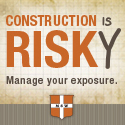
| www.agc.org • August 2018 |
Contact Us Archives
Subscribe Printer-Friendly AdvertiseSafety and HealthFacebook |
Safety Checklists: Using Technology to Protect Workers on the Jobsite BY DR. SERGEY SUNDUKOVSKIY, CO-FOUNDER AND CHIEF TECHNOLOGY AND PRODUCT OFFICER
RAKEN, AN AGC OF CALIFORNIA AND SAN DIEGO CHAPTER MEMBER
Safety matters on the jobsite. Workers face any number of dangers during the typical construction project. A contractor’s No. 1 priority is always keeping everyone safe while they are on site.
THE NEED FOR SAFETY
According to the Occupational Safety and Health Administration (OSHA), 21.1 percent of private sector work-related deaths occurred in the construction industry in 2016 — that’s one in five worker deaths. The most common causes are falls, being struck by objects, electrocution and being trapped or crushed by equipment.
PROTECTING WORKERS
The first step toward protecting workers is the consistent management of jobsite conditions and safety procedures through the use of ongoing construction safety checklists and safety reports.
A construction safety checklist is a list of questions that construction supervisors or superintendents answer daily to assess jobsite safety. Checklists for construction environments typically contain a few standard questions, but they can be customized to fit the needs of any type of contractor. For electricians, checklists could be used to ask if there were any leaky batteries or exposed wires reported that day. For roofing contractors, the checklist could ask whether fall protection equipment was in use or had been properly inspected.
Here are some examples of questions that can be included in a daily safety checklist.
BENEFITS OF USING TECHNOLOGY
Safety checklists are great tools but only if used consistently. The necessary daily reporting can easily fall by the wayside under the relentless pressure of deadlines faced by construction supervisors and superintendents.
Unreliable human memory means imperfect recordkeeping. Traditional reporting methods can take hours each week as managers struggle to transcribe facts from separate spreadsheets or notebooks into an understandable narrative.
Easy-to-use cloud-based construction reporting technology can provide a valuable tool to help by relieving managers of the time constraints of old-fashioned pen-and-paper recordkeeping. Designed to run on common mobile devices and smartphones, cloud-based construction monitoring software can allow quick and easy filing of daily reports and keep project managers informed about progress in real-time.
A construction reporting app with a daily survey feature can allow the quick creation of a safety checklist that allows the pertinent data to be entered from the field. The data can be collected and used to automatically generate overall construction safety reports.
In addition, cloud-based construction monitoring apps can be used to track subcontractor compliance. The apps can allow subs to seamlessly send reports to construction supervisors. The summary can provide evidence if subs are dealing with safety issues. Each subcontractor’s report information can be easily sorted and filtered.
PUTTING IT ALL TOGETHER
A safety report produced by construction monitoring software allows project managers to see project trends and get a high-level view of safety issues. Graphs and visuals can provide snapshots of everything project managers need to know, while providing the necessary information to make improvements to workflow and processes on the jobsite. This allows contractors to ensure dangers are identified, sites are safe and injuries are reported.
LITIGATION PROTECTION
Safety checklists and reports can help litigation-proof construction projects. Once recorded in a cloud-based centralized database, data can be easily retrieved. Project managers can almost instantly locate whatever information they need. The best protection against litigation is thorough documentation of safety issues, jobsite conditions, weather conditions, injuries, inspections, compliance reports and other data.
For instance, in one scenario, someone files litigation against a contractor alleging they were injured because safety equipment was faulty. Being able to quickly produce documentation that the equipment was in good working order and had been properly inspected, or that the user had not followed safety protocols, can help discredit the allegations.
SUMMING IT ALL UP
According to OSHA, overall worker deaths in the United States have fallen dramatically from historical levels — from about 38 worker deaths per day in 1970 to 14 per day in 2016; however, the sad truth is that the construction industry continues to lead the private sector in total worker deaths and injuries. Construction workers are injured at a rate 77 percent higher than the national average for other occupations. By consistently using management tools such as construction safety checklists and safety reports, the construction industry can begin to turn the tide, making jobsites safer for workers. Dr. Sergey Sundukovskiy is co-founder and chief technology and product officer for Raken, based in San Diego. Raken has revolutionized daily reporting in the construction industry. Raken provides innovative mobile technology that automatically creates professional company branded daily reports from inputs made in the field by superintendents and foremen.
|
|||
 2300 Wilson Boulevard, Suite 300 · Arlington, VA 22201 · 703-548-3118 (phone) · 703-548-3119 (fax) · www.agc.org
2300 Wilson Boulevard, Suite 300 · Arlington, VA 22201 · 703-548-3118 (phone) · 703-548-3119 (fax) · www.agc.org
About AGC | Advocacy | Industry Topics | Programs and Events | Career Development | News & Media
© Copyright 2025 The Associated General Contractors of America. All rights reserved.

